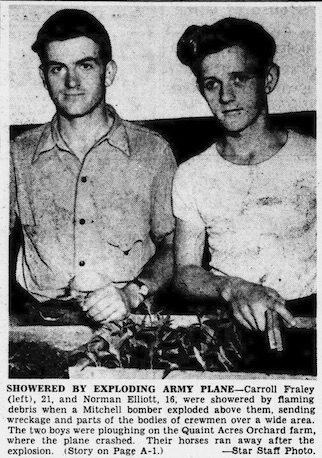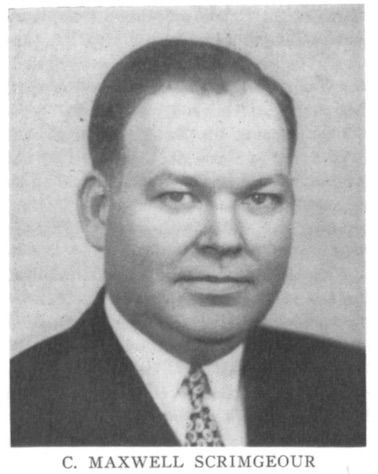White Oak, MD B-25 Crash, 1945
May, 1945, before there was a Naval Ordnance Lab, a White Oak Shopping Center, or The Enclave/The Point - just three months from VJ day and the end of World War II. A North American B-25 bomber leaves Keesler Field in Biloxi, Mississippi, bound for Bolling Field, Washington, D.C.
But the B-25 will never make it...this is the story of the White Oak crash.
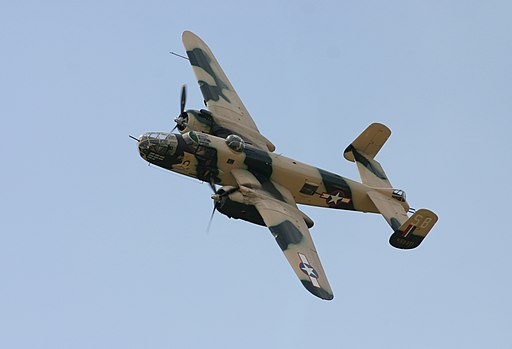
Image by User:Lukas skywalker,Wikimedia Commons
Aircraft Accidents During WWII
Why haven't you heard about the White Oak B-25 crash before? According to the AAF Statistical Digest, in less than four years (December 1941-August 1945), the US Army Air Forces lost 14,903 pilots, aircrew and assorted personnel plus 13,873 airplanes inside the continental United States. They were the result of 52,651 aircraft accidents (6,039 involving fatalities) in 45 months. That was nearly 40 a day (although less than one accident in four resulted in total loss of the aircraft). While an aircraft crash in the US during WWII was locally notable, they rarely lead to national notice.
Quaint Acres
Altus Lacy Quaintance, a State Entomologist of Maryland, retired in 1940 to his farm called "Quaint Acres" where he propagated fruit and ornamental nursery stock.
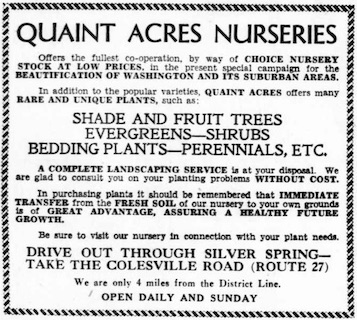 |
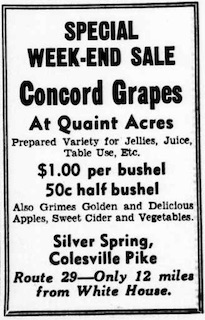 |
| Sunday Star, Apr, 18, 1932 | Evening Star, Sept. 16, 1939 |
The Crew
The pilot of TB-25D serial number 41-30428 was Colonel Dudley Miller Outcalt. Col. Outcalt flew with Capt. Eddie V. Rickenbacker in the 94th Aero Squadron as a second lieutenant during WWI. He then became a prosecutor and later judge of the Common Pleas Court in Cincinnati, Ohio. He conducted the State's case in 1937 against Anna Marie Hahn, a German-born American serial killer and the first woman to die in Ohio's electric chair. Outcalt went back into the army in 1942. At the time of the crash, he was living at the Governor Shepherd Apartments, 2121 Virginia Avenue, N.W., DC.
Staff Sergeant William C. Moberly, 28, crew chief and flight engineer, was from Frederick, Maryland. He and his wife had two children. At the time of the crash, they lived at 4410 Third St. S.E., DC.
Staff Sergeant Frank A. Pogorelski, 24, radio mechanic, had been in the Army five years, and was from Throop, Pennsylvania. He and his wife celebrated their first wedding anniversary on May 6, 1945, 20 days before the crash. At the time of the crash, they were living at 1320 Anacostia Road, S.E., DC.
Also on the plane was Private William J. Knaub, 19, from York Country, Pennsylvania, as a "hitchhiker".
Ardley Ballin Cross, Sr., was going to be on the doomed flight, but was deleted from it before takeoff. He lived until 1991.
The Flight
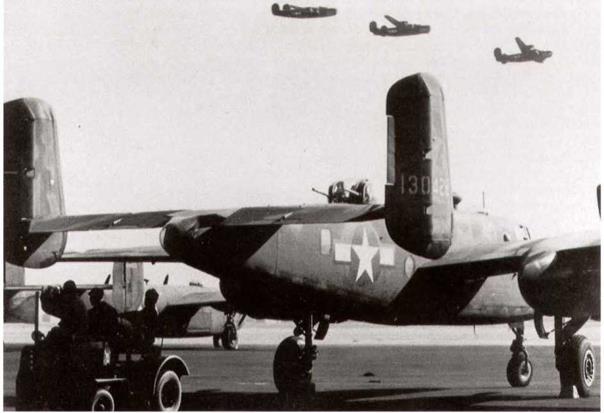
This is a picture of the B-25 involved in the crash, 41-30428, when it was serving in the 12th Air Force in North Africa in 1943
The morning of 26 May 1945, Army B-25D 41-30428 took off from Keesler Field, Biloxi, Mississippi on a flight to Bolling Field, Washington, DC. Col. Outcalt contacted Richmond, Virginia, radio at 12:56 EWT (Eastern War Time), giving his position as 5 miles southeast of Richmond. Washington ATC gave clearance to Richmond radio at 12:58 EWT, instructing the pilot to descend immediately to 7,000 feet, to maintain that altitude until further advised, and to contact Washington radio upon arrival at Doncaster. Outcalt radioed back that he was unable to read Richmond radio's transmission, and was proceeding to Washington at 11,000 feet.
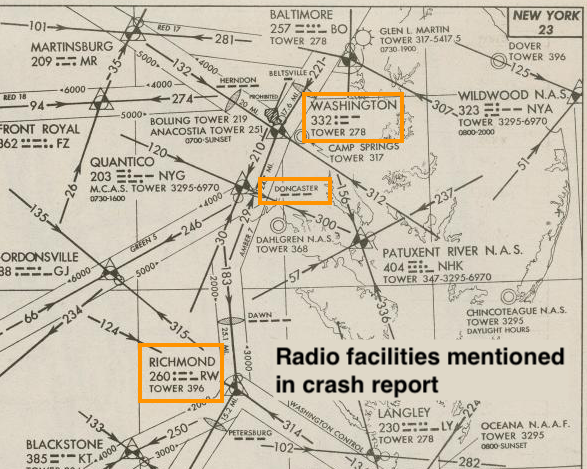
At 13:10, William J. Lochridge was at his home at 920 S. Ode St. in Arlington, Virginia, when he saw the silver-colored B-25 fly over his house at 300 feet headed northeast with its landing gear extended. His house was near where the Air Force Memorial is today. The B-25 was then only about 3 miles west northwest of Bolling Field. Evidently, the plane continued 14 miles to the north northeast to White Oak.
Nothing further was heard of the aircraft until crash notice was received at Bolling Field at 13:40 EWT.
White Oak in 1945
In 1945, Colesville Road (formerly the "Washington, Colesville and Ashton Turnpike") extended north from Silver Spring to White Oak to meet New Hampshire Avenue along the alignment of today's Lockwood Drive. "Colesville Road" then continued north along today's New Hampshire Avenue. Paralleling the path of today's Route 29 from New Hampshire Avenue in White Oak to Columbia was the "Columbia Pike", parts of which are known today as "Old Columbia Pike", including the now closed old bridge over the Paint Branch.
1945 2016 Click and drag to compare maps
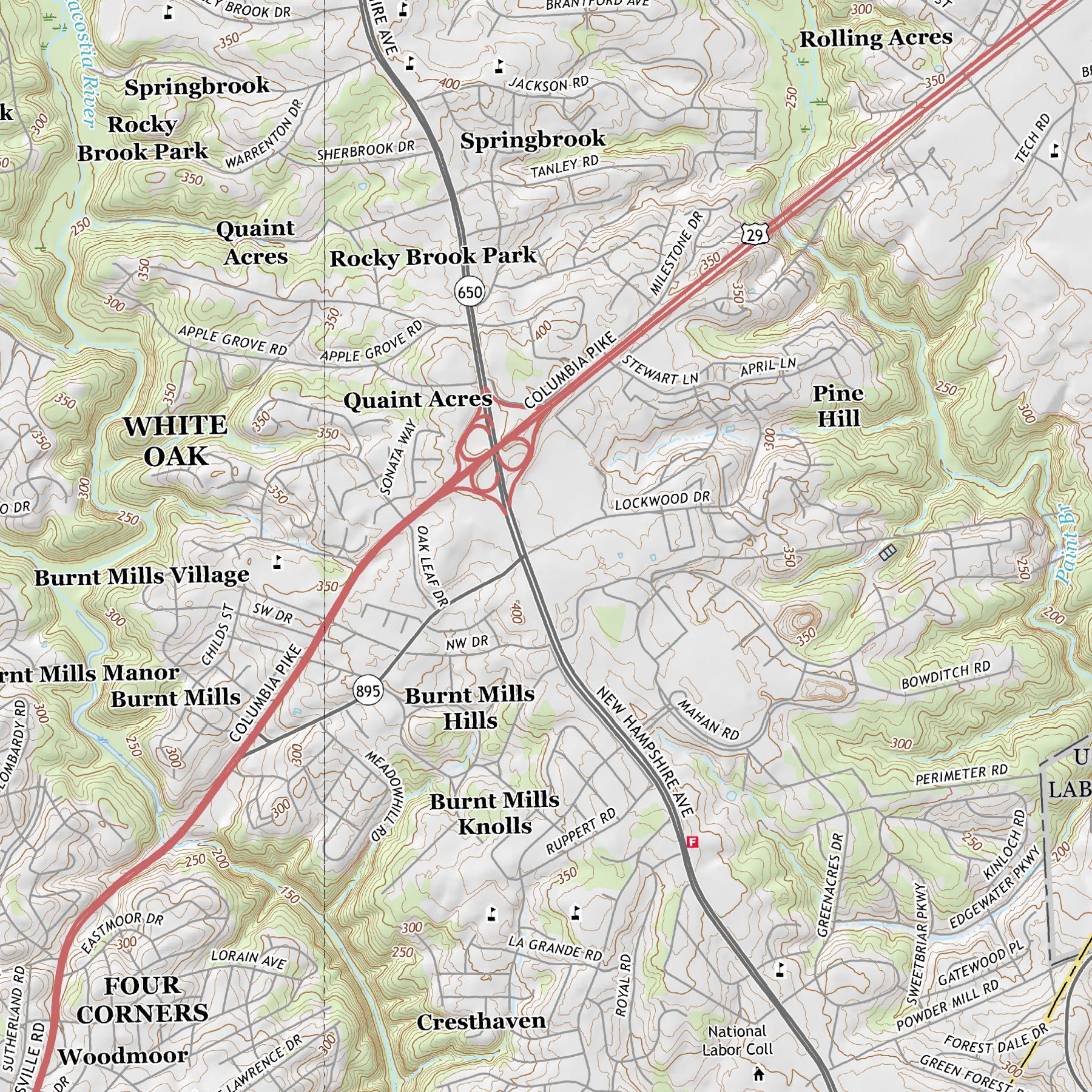
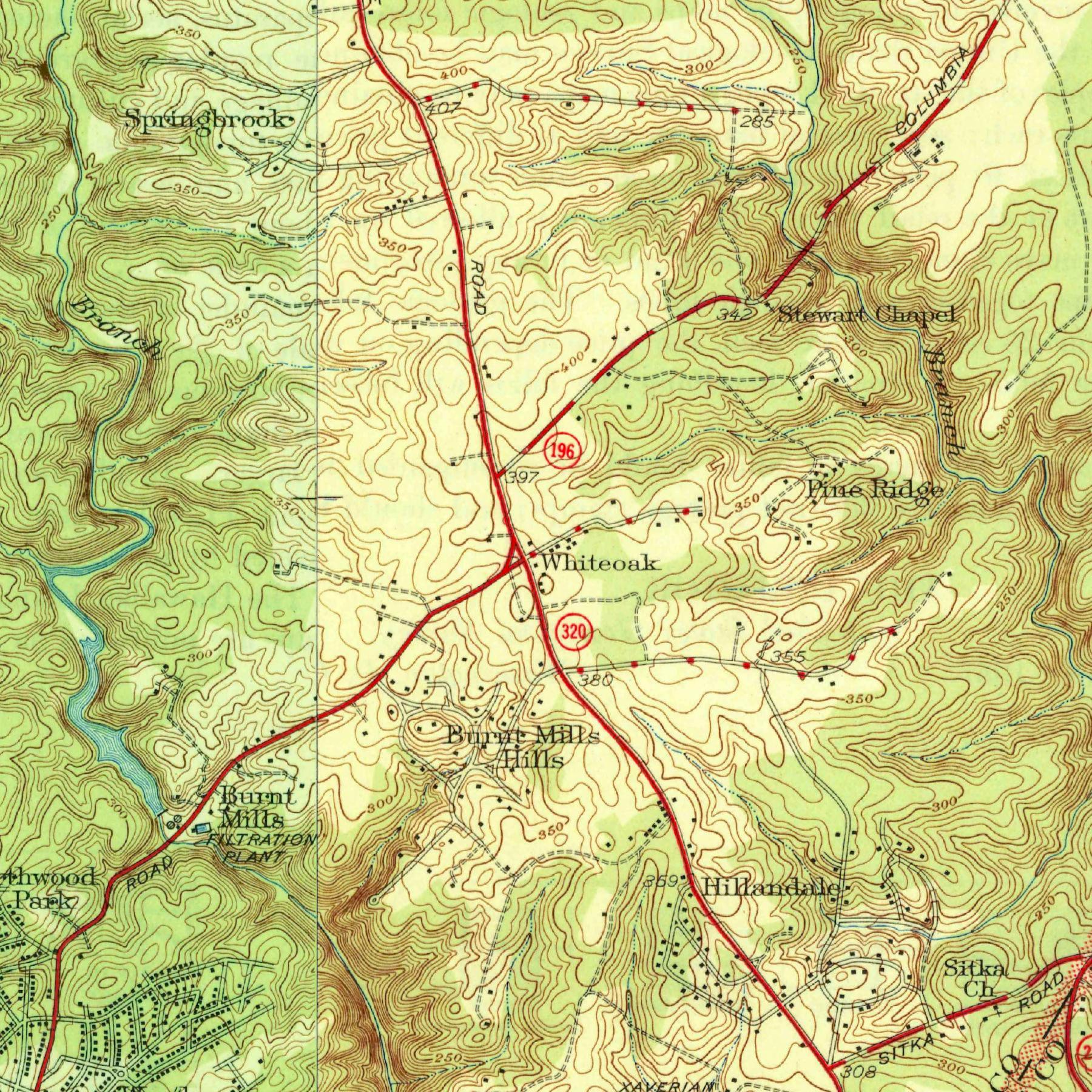
The Crash
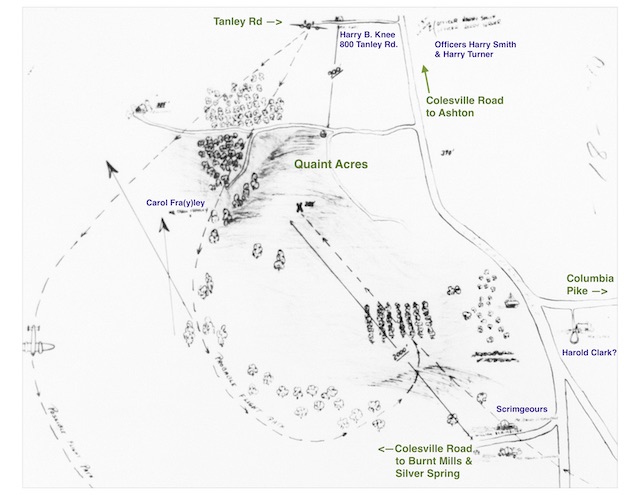
The aircraft, in no apparent mechanical difficulty, was first seen approaching from the northeast, flying a southwest course under the overcast, which was estimated to be approximately 500 feet with tops of hills partially obscured by clouds. The aircraft disappeared into the clouds, and was then observed by William Scrimgeour to come down out of the clouds in a steep dive, disappear behind a knoll, and then he saw an explosion in the sky. As the crash occurred, the aircraft was traveling in a northwesterly direction. Coming in contact with the ground in a low flat angle, the airplane ricocheted into the air, and exploded with such force as to demolish completely the aircraft and its occupants.
Altus L. Quaintance said the plane crashed into a section of his orchard and woodland.
Orchard worker Charles F. Elliott, and his son, Norman Elliott (age 16) and Carroll Fraley (age 21) had returned to their ploughing around 1:15 PM and said they were almost beneath the plane when it exploded. "We had just returned to the field from lunch," Mr. Elliott said, "and were behind some bushes when we heard a loud explosion. We then saw parts of the plane flying in all directions and great balls of fire all around us. We were dodging and ducking as plane parts and fire fell around us. Our team of horses, frightened by the explosion, ran away"
Carroll Fraley: "The plane was coming in from the southeast...I heard the plane coming and was trying to see it, but did not till it hit. It hit and blew up at the same time. The plane made a steady roar until it hit. I didn't hear any sputtering. It sounded to me like he had opened the motor and like he was in a dive, but evidently it was not in a dive. I saw the plane coming in this direction and saw it head at the field. I am quite sure it hit the ground before it blew up."
Policeman Mr. Harry Smith: "The first thing I noticed was this flash, this red light like a red mist. It was over rapidly. I was about a mile down the road with my boy and the bicycle when I turned my head and heard the explosion. I didn't see the airplane - there were just pieces. From my front yard you can see this group of trees. It looked like confetti coming down. I got down here in a couple of minutes. I heard the motor but didn't see the plane. The motor sounded just like any other plane. When I saw this light, I didn't pay much attention to it. It went through my mind that it was funny lightning. I turned my eye to the terrific noise and saw the pieces coming down. It was just one explosion. There was a loud explosion and then a tremor. It was a loud boom and a quiver. I could hear vibration in the air...the airplane sounded normal before the explosion...before this happened, I heard the airplane not more than 2 minutes before. I was working on the bicycle and heard the roar of the plane. It was loud."
Policeman Harry A. Turner, Jr.: "I live about 3 1/2 miles down the road. I was in the house when I heard this plane. It sounded to me like it was missing. A few minutes [later] I saw it like it was on the ground. Suddenly there was a big explosion. It was about five or ten minutes from the time I saw it pass my house. He was coming down by the big trees. It was running along the ground. It looked like it was trying to make a landing, and then it blew up. It was on fire when it was running. It blew up on the ground. It looked like when it was running on the ground something burst and it went up and burst again. It jumped a little bit and got afire. It was not over 500 feet when it came over my house. It was popping every once in a while. In between it would run along alright...it was foggier yesterday. The clouds were handing real low yesterday. It happened about 1:25."
Harry B. Knee [who lived at 800 Tanley Rd. in a house that is still there]: "My wife was on the porch and I was standing here (in front of the house to the left of the porch). The plane was not over about fifty or sixty feet, and then it swerved up through the gully. Something fell out of it. I imagine it was the engine. It had not gone about 100 feet when it went right up. It was not more than 100 feet at the time. My wife and I were the first to get over to it. The ceiling was lower than it is today. It sounded like only one engine was going and the other was not. There was not exactly a smoke, but more of a steam which burst in mid-air. It was like a big bomb in the air. The sky was filled with debris. I don't think he was over 30 or 40 feet over this house. He was right side up. When I got over there, I found the sergeant's identification tags and red tags on the barracks bag, which I brought back and put in the police car, and identification was radioed in."
Frank S. Pohanka, a well-known Washington automobile dealer, heard a low-flying pane over his home at Burnt Mills Hills. He said that the engines were functioning properly as the plane flew over at 500 feet, but shortly afterward he heard a slight explosion, followed in a few moments by a tremendous blast. Mr. Pohanka jumped into his automobile and drove to the field where the wreckage dropped. When he arrived, he saw at least 20 fires burning from pieces of wreckage strewn over three-eighths of a mile.
Harry R. Clark's family owned the "White Oak Farm." The farm name was likely a tribute to a white oak tree on the property believed to have been 400 years old. Giant Food Properties would later purchase the Clark family’s White Oak Farm and developed the 28-acre White Oak Shopping Center. Clark reported: "The plane came from over here and went over the trees. The consensus of opinion was that there were three loud crashes. The it hit and there was a big crash, then it hit again and there was another big crash. There was a big flash of fire. I don't know whether it was from the ground or from the air. I don't think the weather was as bad yesterday as it is today. His motors seemed to be working good. Everybody seemed to hear this muffled explosion and a crash, then another crash. It his one place, then another place. The engines have been working alright. We could hear it. I couldn't tell how close he was down here, but he was very close. My son saw it just as it disappeared over the trees, and then the ball of fire. When he saw the fire, it passed out of sight."
The Scrimgeours lived along the north side of today's Lockwood Drive near the intersection with today's New Hampshire Ave. The family patriarch was William Scrimgeour, born in Scotland in 1870 and lived in Washington, D.C. His sons Charles Bailey and Carter Maxwell lived in White Oak, along with his grandson William MacGregor. The family owned companies that supplied materials for the Army and Navy during WWII. After the war, William and Carter Maxwell would help to found the Bank of Silver Spring, which later became the American National Bank of Silver Spring, eventually going through many mergers to become part of Wells Fargo. William was also granted a patent on a diving helmet, a method of making eating utensils and a hypodermic syringe.
Carter Maxwell Scrimgeour: "The plane was more than 300 to 400 feet off of the ground when the explosion happened. He exploded right in the air. It went off like a perfect ball of fire. In my opinion, the motors were going when the explosion occurred. Sometimes planes fly very low around here, and what attracted us was this heavy blast of motor. I couldn't see the plane, and as I was looking through the clouds, it went off. When it went off the motors were running steady. Visibility was very low. The plane was not on fire when it came down. The only light was the one blast. The idea that the plane hit the ground in coming past is all wrong. From here to where it happened I estimate at 2000 feet. I looked for him for half a minute, but nobody could have seen that plane. He was above the ceiling in clouds. There was one explosion, and his motors were full blast when it exploded. So far as I'm concerned, it went off in the air."
Charles Bailey Scrimgeour: "It sounded as if the plane went right over this house. The plane exploded in the air. The metal parts showed that. Generally when you have an explosion it goes in one direction, but part of that plane went forward and part to the rear. It was scattered in the vineyard, then nothing in the valley till you got to the hill. It was like the motors all went forward. The smoke was not scattered, but when straight up. What was significant to me was - I went up there with three captains. They and the superintendent were down the road and we picked them up. This elderly man had a piece of cloth that was bloody. I noticed the yellow tag on a 'chute that said it had been packed at Bolling Field. It seemed to me as if there was something wrong with the motors. We felt the vibration of the plane. It happened somewhere between 1:20 and 1:25, I looked at the clock."William MacGregor Scrimgeour: "I saw the plane going down before it blew up. I don't think the plane was on fire. I thought he was doing stunt flying. I saw him come by and there was a terrific explosion. I think it exploded before it hit the ground. The plane came right over the house. It seemed like it was going northwest. I couldn't see it when it went over the clouds. I heard the explosion and saw the wing going up. It looked like there was a black smoke and then the terrific explosion. I thought he hit on the top of the hill."
 |
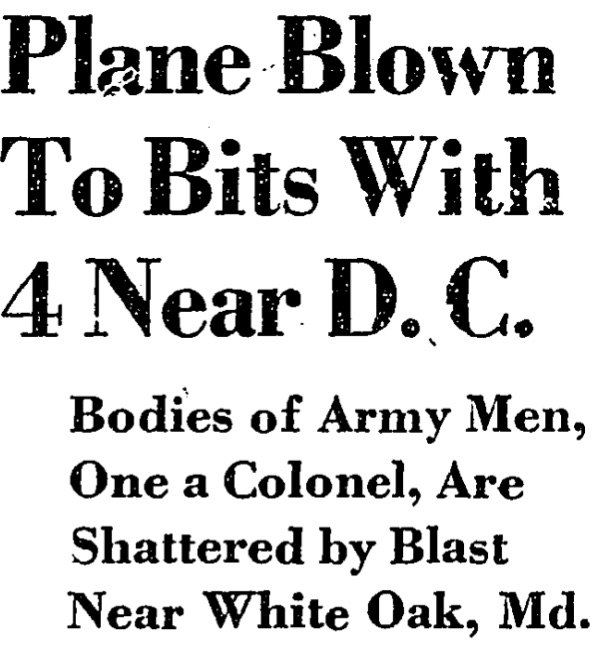 |
|
| Sunday Star headline, May 27, 1945 | Washington Post headline, May 27, 1945 |
Link to Full Crash Report
Investigation Findings
Weather was a factor in that the pilot apparently tried to let-down through the overcast and make a CFR approach to Bolling Field [Contact Flight Rules, the predecessor to Visual Flight Rules, or VFR. In CFR, the pilot is supposed to maintain visual "contact" with the ground]. Weather conditions were such that "contact" flight would have been difficult if not impossible over the rolling hill country outside the Potomac river valley.
Due to the lack of sufficient evidence of any mechanical failure, also sufficient evidence to determine actual cause of the accident, the following is the assumption of the Board as to what happened: It is concluded that the pilot, after getting contact underneath the clouds, was proceeding southwest trying to get back to Bolling Field. It is believed that the clouds were so low that this was impossible and the pilot, upon getting into the very low clouds, decided to make a 180 degree turn and proceed north to better weather. The pilot would have had to go on instruments while making this turn, and he either came out of the clouds at a steep enough angle that he could not pull up upon seeing the ground, or the top of the hill was covered with clouds so that he could not see it before hitting.
The crash report stated a violation of AAF Regulation 60-16 is indicated in that the pilot, while conducting an IFR flight, was not given any approach clearance, but descended from 11,000 feet to tree-top level without approval of Army Flight Service or Airways Control, Washington.
After the Crash
White Oak was a very rural area in 1945. Shortly after the crash, the Naval Ordnance Lab opened. Quaint Acres was turned from an orchard and nursery into a suburban development.
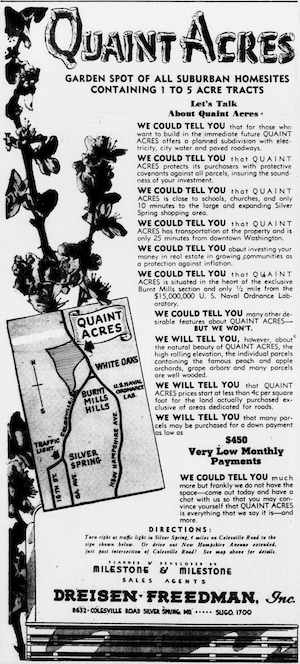
|
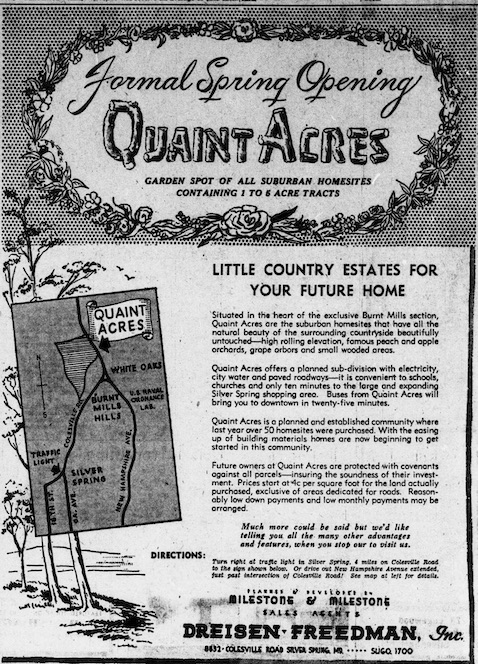
|
|
| Evening Star, Sept.21, 1946 | Evening Star, May 10, 1947 |
Quaint Acres would later become the home of the famous conservationist, Rachel Carson, author of Silent Spring.
The precise location of the crash with respect to modern landmarks is unclear, but it was likely somewhere south of today's Quaint Acres Dr., but north of today's Colesville Rd./Route 29. Interestingly enough, the area between the Quaint Acres housing development and Route 29, today known as "Symphony Woods", was undeveloped until the mid-1980's, one of the last "rural" parts of White Oak to become developed.
Postscript
When I first began investigating this crash in 2008, I was hoping that there might be at least one surviving eyewitness. Unfortunately, I did not have the research tools to track down William McGregor Scrimgeour before his passing in 2013. I still don't know who Policeman Mr. Harry Smith (maybe "Henry Smith"?) or his boy are, nor can I identify Harry R. Clark who on the crash report map appears to occupy land on which the White Oak shopping center was built. Charles F. Elliott appears to have died in 1960, and Carroll Fraley in 1995. My condolences to all the families of the victims on the plane and to the eyewitnesses that we have lost in the years since the B-25 crash at White Oak.
